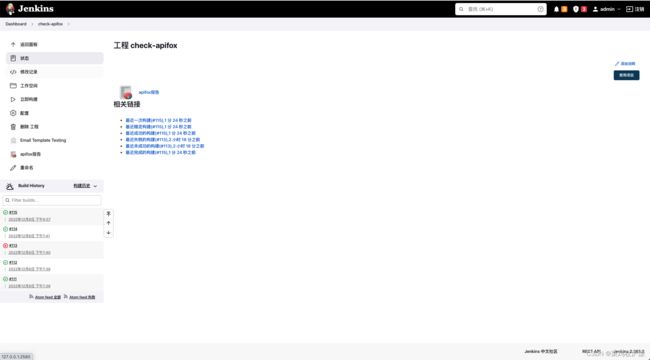从零打造属于自己的CI/CD Jenkins+Apifox (三)
前面讲解了 Jenkins 集成 Apifox 以及 自定义企业微信提醒通知。
下面讲解 邮件附件内保留最新的报告内容。
如果各位看官是从 Jenkins集成Apifox(Jenkins简单的集成Apifox)开始跟着进行搭建的话。进行到这一步就很不容易啦!
千万不要跳着 进行搭建,一定要跟着我的脚步进行集成,否则可能会集成失败!
1、创建 Python 脚本
比如:/Users/xxxx/data/jenkins_home/workspace/check-apifox/apifox.pyimport argparse
from logging import exception
import os
import sys
import re
class ApifoxScript:
# 删除指定文件夹和文件
def delete_dirs(self, path, keep_files_num):
# path:删除文件的路径
# keep_files_num:路径下需要保存的文件数量
print("开始执行删除")
for root, dirs, files in os.walk(path):
# root:当前文件夹地址
# dirs:当前文件夹下的所有目录list
# files:当前文件下的所有文件list
print(files)
# 遍历删除目录
for name in dirs:
dir_path = os.path.join(root, name)
# print(dir_path)
if os.path.exists(dir_path):
try:
os.rmdir(dir_path)
except exception as e:
print('删除文件夹失败' + e)
path_time_list = []
file_path = ''
# 获取文件最后修改时间,保留最新的keep_files_num数量的文件,删除多余文件
for file in files:
file_path = os.path.join(root, file)
path_time = os.path.getmtime(file_path)
path_time_list.append(path_time)
# 待删除的文件地址日期list
del_path_time_list = sorted(path_time_list, reverse=True)[keep_files_num:]
del_path_list = []
# 根据del_path_time_list找到需要删除的文件地址del_path_list
if len(del_path_time_list) > 0:
for path_time in del_path_time_list:
for file in files:
try:
file_path = os.path.join(root, file)
if os.path.getmtime(file_path) == path_time:
del_path_list.append(file_path)
except exception as e:
print("读取文件目录错误" + e)
else:
print("文件未达到 " + str(keep_files_num) + " 份,无需删除")
print(del_path_list)
# 删除文件
for del_path in del_path_list:
try:
if os.path.exists(del_path):
os.remove(del_path)
except exception as e:
print("删除文件出错" + e)
# 指定本python文件通过bash或shell命令运行时外部传入的参数
def parse_args(self):
print(sys.argv)
default_apifox_cli = r"apifox run https://api.apifox.cn/api/v1/api-test/ci-config/356368/detail?token=x0zxxxxxxrIb9xxxxxNB_Asw-QY -r html,cli "
database_json_path = '/var/jenkins_home/workspace/check-apifox/database-connections.json'
parser = argparse.ArgumentParser()
# Jenkins中job的名字
parser.add_argument("--job-name", dest="job_name", type=str, action="store", default='check-apifox')
# Jenkins中job的第n次构建
parser.add_argument("--build-number", dest="build_number", type=int, action="store", default=95)
# 需要保留的文件数量
parser.add_argument("--set-num", dest="set_num", type=int, action="store", default=10)
# apifox测试用例或测试套件命令
parser.add_argument("--apifox-cli", dest="apifox_cli", type=str, action="store", default=default_apifox_cli)
# 数据库配置
parser.add_argument("--database-json-path", dest="database_json_path", type=str, action="store",
default=database_json_path)
args = parser.parse_args()
return {"job_name": args.job_name, "build_number": args.build_number, "set_num": args.set_num,
"apifox_cli": args.apifox_cli, "database_json_path": args.database_json_path}
# 判断报告中是否存在失败的用例
def html_result(self, html_path, status_path):
# 定义报告的执行结果默认为True
# html报告只有失败的时候会有‘失败情况’四个字,读取报告检索是否有这四个字即可知道
# 测试用例的执行情况
cases_result = True
try:
with open(html_path, "r", encoding='utf-8') as f:
html = f.read()
res_list = re.findall("失败情况", html)
print(res_list)
if len(res_list) != 0:
cases_result = False
# 根据报告结果将结果写入txt中
with open(status_path, "w", encoding="utf-8") as t:
if cases_result:
t.write("STATUS=Passed")
print("STATUS=All cases passed")
else:
t.write("STATUS=Failed")
print("STATUS=Some cases failed")
f.close()
t.close()
except exception as e:
print("读取报告html文件失败" + e)
if __name__ == '__main__':
apifox = ApifoxScript()
args_dict = apifox.parse_args()
apifox_cli = args_dict.get("apifox_cli")
database_json_path = args_dict.get("database_json_path")
job_name = args_dict.get("job_name")
set_num = args_dict.get("set_num")
build_number = args_dict.get("build_number")
print("database_json_path: " + database_json_path)
if database_json_path:
apifox_cli = apifox_cli + " --database-connection " + database_json_path
print("apifox_cli: " + apifox_cli)
base_path = r"/var/jenkins_home/workspace"
report_path = base_path + "/" + job_name + r"/apifox-reports"
report_name = job_name + "_" + str(build_number)
print("report_path: " + report_path)
print("report_name: " + report_name)
# 执行删除html报告
apifox.delete_dirs(report_path, 10)
print("删除完毕")
# 执行apifox命令
apifox_full_cli = f"{apifox_cli} --out-file {report_name} --out-dir {report_path}"
print("apifox_full_cli: " + apifox_full_cli)
msg = os.system(apifox_full_cli)
print("运行apifoxbash结果")
print(msg)
# 判断用例执行结果,附加在推送邮件中
html_report_path = report_path + "/" + report_name + ".html"
print("html_report_path: " + html_report_path)
status_path = base_path + "/" + job_name + r"/build_status.txt"
print("status_path: " + status_path)
apifox.html_result(html_report_path, status_path)
Jenkins内操作
1、修改 执行 shell
进入项目-Build Steps
/usr/bin/python3 "apifox.py" --apifox-cli "apifox run https://api.apifox.cn/api/v1/api-test/ci-config/356368/detail?token=x0zaxxxxrIbxxxx_Asw-QY -r html,cli" --database-json-path "database-connections.json" --job-name ${JOB_NAME} --set-num 10 --build-number ${BUILD_NUMBER}
详解:
apifox.py: Python脚本
--apifox-cli: 执行命令
--database-json-path: 数据库配置
--job-name: job名称
--set-num: 保留次数
--build-number: 构建次数2、修改 Editable Email Notification
进入项目-构建后操作-Editable Email Notification-Attachments
apifox-reports/${JOB_NAME}_${BUILD_NUMBER}.html
详解
apifox-reports: 报告目录名称
JOB_NAME: job名称
BUILD_NUMBER: 构建次数3、保存后 进行构建
构建成功
构建详情



